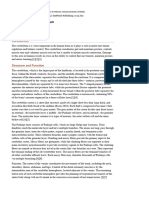PSYCHOLOGY
PSYCHOLOGY
Uploaded by
gunjandas7846Copyright:
Available Formats
PSYCHOLOGY
PSYCHOLOGY
Uploaded by
gunjandas7846Copyright
Available Formats
Share this document
Did you find this document useful?
Is this content inappropriate?
Copyright:
Available Formats
PSYCHOLOGY
PSYCHOLOGY
Uploaded by
gunjandas7846Copyright:
Available Formats
Q.
Explain the structure and function of Neuron to
justify “Neuron as the Biological base of Behavior”.
ANSWER-
The neuron is often referred to as the biological base of behavior
because it is the fundamental building block of the nervous system
and is responsible for transmitting information within the brain and
throughout the body. Neurons have a highly specialized structure and
function that makes them uniquely suited for this role.
Structure of a Neuron:
A typical neuron consists of several key components, each with a
specific function:
1. Cell Body (Soma): The cell body contains the nucleus and other
organelles necessary for maintaining the neuron's metabolic and
genetic functions.
2. Dendrites: Dendrites are short, branched extensions that receive
incoming signals from other neurons or sensory receptors. They play
a crucial role in collecting and integrating information.
3. Axon: The axon is a long, slender projection that carries electrical
signals (action potentials) away from the cell body and toward other
neurons, muscles, or glands.
4. Axon Terminal: At the end of the axon, there are terminal branches
with synaptic knobs or end bulbs that transmit information to the
next neuron or target cell through synapses.
5. Myelin Sheath: Some neurons are covered with a myelin sheath,
which is produced by glial cells. The myelin sheath insulates the axon,
allowing for faster and more efficient transmission of electrical
impulses.
Function of a Neuron:
Neurons are specialized to perform the following functions, which are
integral to behavior and the functioning of the nervous system:
1. Signal Transmission: Neurons communicate with each other and
with target cells through electrochemical signals. When a neuron
receives a strong enough stimulus, it generates an action potential,
an electrical impulse that travels down the axon. This allows for rapid
transmission of information over long distances.
2. Information Processing: Dendrites collect input from multiple
sources, and the cell body integrates this information. The neuron
then makes decisions about whether to generate an action potential
based on the integration of incoming signals.
3. Synaptic Transmission: At the axon terminals, neurons
communicate with other neurons or target cells at synapses.
Neurotransmitters are released into the synaptic cleft, where they can
excite or inhibit the next neuron's activity, influencing the direction
and strength of the signal.
4. Plasticity: Neurons can change their connections and functions in
response to experience and learning. This plasticity is fundamental to
behavioral adaptations and memory formation.
5. Coordination of Behavior: Neurons form complex networks that
control and coordinate various behaviors, from basic reflexes to
complex cognitive processes. The collective activity of many neurons
working together underlies all human behaviors.
In summary, neurons are the basic units of the nervous system, and
they are specialized for the transmission of information, information
processing, and coordination of behavior. Their unique structure and
function make them the foundation of all physiological and
psychological processes, which is why they are often considered the
biological basis of behavior. The way neurons transmit and process
information is crucial for understanding how the nervous system
influences our thoughts, emotions, and actions.
Q. Describe the Human Nervous System with its
functions.
ANSWER-
The human nervous system is a complex network of specialized cells
that enable communication and coordination within the body. It plays
a crucial role in controlling and regulating various physiological and
psychological processes. The nervous system can be divided into two
main parts: the central nervous system (CNS) and the peripheral
nervous system (PNS). Here, I'll describe the components and
functions of both systems:
1. Central Nervous System (CNS):
- The CNS consists of the brain and the spinal cord.
- Brain: The brain is the control center of the nervous system and is
responsible for cognitive functions, sensory perception, motor control,
and emotional processing. It interprets and processes sensory
information and initiates appropriate responses.
- Spinal Cord: The spinal cord serves as a relay and processing
center for information traveling between the brain and the peripheral
nervous system. It also controls reflex actions, allowing rapid
responses to certain stimuli without requiring input from the brain.
Functions of the CNS:
a. Processing and integrating sensory information.
b. Initiating and coordinating voluntary and involuntary
movements.
c. Managing cognitive functions, including thinking, memory, and
decision-making.
d. Regulating emotional responses and behavior.
e. Controlling homeostasis and autonomic functions like heart rate,
blood pressure, and respiration.
2. Peripheral Nervous System (PNS):
- The PNS includes all the nerves and ganglia (clusters of nerve cell
bodies) outside the CNS. It can be further divided into two
components: the somatic nervous system and the autonomic nervous
system.
a. Somatic Nervous System (SNS):
- The SNS is responsible for voluntary muscle movements and the
relay of sensory information to the CNS.
- Motor Neurons: These neurons control skeletal muscles and
enable conscious movements.
- Sensory Neurons: They transmit information from sensory
receptors (e.g., in the skin, muscles, and joints) to the CNS.
b. Autonomic Nervous System (ANS):
- The ANS regulates involuntary bodily functions, such as heart
rate, digestion, and respiratory rate. It is further divided into the
sympathetic and parasympathetic branches.
- Sympathetic Nervous System: Prepares the body for "fight or
flight" responses, increasing heart rate, dilating pupils, and
redirecting blood flow to muscles.
- Parasympathetic Nervous System: Promotes "rest and digest"
responses, slowing heart rate, constricting pupils, and directing blood
flow to digestive and restorative processes.
Functions of the PNS:
a. Transmitting sensory information from the periphery to the CNS.
b. Regulating involuntary bodily functions to maintain homeostasis.
c. Controlling motor functions and voluntary muscle movements
through the SNS.
d. Orchestrating responses to external and internal stimuli through
the autonomic nervous system.
In summary, the human nervous system is a highly sophisticated and
intricate system that plays a vital role in maintaining and regulating
various bodily functions, cognitive processes, and responses to the
environment. The CNS and PNS work in tandem to ensure that the
body can perceive, interpret, and respond to its surroundings
effectively.
You might also like
- Cns Summarised Lecture Notes All CnsDocument166 pagesCns Summarised Lecture Notes All Cnspoopzi100% (1)
- Weekly AssignmentDocument7 pagesWeekly AssignmentBajwa AyeshaNo ratings yet
- Nervous System Transes 1Document6 pagesNervous System Transes 1Rhodie BatislaonNo ratings yet
- Anatomical Divisions of The Nervous SystemDocument11 pagesAnatomical Divisions of The Nervous SystemDamianNo ratings yet
- The Nervous SystemDocument10 pagesThe Nervous Systemhajra0325No ratings yet
- The Study of Nerves Is Known As Neurobiology or NeuroscienceDocument3 pagesThe Study of Nerves Is Known As Neurobiology or Neurosciencebryanpiit24No ratings yet
- Nervous and Endocrine System Test ChecklistDocument4 pagesNervous and Endocrine System Test Checklistbhoumik.malipeddiNo ratings yet
- Chapter 12 Neural TissueDocument15 pagesChapter 12 Neural TissueKatherine De San AgustinNo ratings yet
- ??????? ?????? H. Idris N. Macmod A. Mangondato M. OmarDocument70 pages??????? ?????? H. Idris N. Macmod A. Mangondato M. OmarHestia GreyertNo ratings yet
- Notes On The Nervous SystemDocument2 pagesNotes On The Nervous Systemanniefernz2003No ratings yet
- Class NotesDocument4 pagesClass Notesdaniel holmesNo ratings yet
- Coordinated Functions Nervoys SDocument3 pagesCoordinated Functions Nervoys SGwency Ross Alvarez (Gwen)No ratings yet
- Brain As A CPU SystemDocument3 pagesBrain As A CPU SystemKaran S100% (4)
- Biological Basis of BehaviorDocument6 pagesBiological Basis of BehaviorLyanna MormontNo ratings yet
- Lesson 3 The Neuromotor Basis For Motor Control v2Document11 pagesLesson 3 The Neuromotor Basis For Motor Control v2Drift AlvinNo ratings yet
- Nervous SystemDocument10 pagesNervous SystemPogi BearNo ratings yet
- Nervous SystemDocument2 pagesNervous SystemJohnreeNo ratings yet
- Module 5 Nervous TissueDocument8 pagesModule 5 Nervous TissueHermione MalfoyNo ratings yet
- Oral Exam ReviewerDocument39 pagesOral Exam ReviewerFayena JoseNo ratings yet
- Oral Exam ReviewerDocument48 pagesOral Exam ReviewerFayena JoseNo ratings yet
- IM AnSci 111 Module 3Document21 pagesIM AnSci 111 Module 3Riza Mae Duran RangasNo ratings yet
- Nervous SystemDocument28 pagesNervous SystemPhoebe dane M PandayNo ratings yet
- Module 2 - PhysioDocument6 pagesModule 2 - PhysioVidisha KandwalNo ratings yet
- Nervous System: Anatomy & PhysiologyDocument92 pagesNervous System: Anatomy & Physiologypuranicole26No ratings yet
- Human Nervous System YfmDocument13 pagesHuman Nervous System YfmSinglpaint MLPNo ratings yet
- Anatomy and Physiology - Module 5Document12 pagesAnatomy and Physiology - Module 5JayR MendonesNo ratings yet
- The Nervous System: DR - Arshad Ali DPT Ipm&R Kmu Ms NMPT RiphahDocument24 pagesThe Nervous System: DR - Arshad Ali DPT Ipm&R Kmu Ms NMPT RiphahAzhar MehmoodNo ratings yet
- G10 Science Q3 Nervous SystemDocument28 pagesG10 Science Q3 Nervous SystemEvadine LeeNo ratings yet
- Nervous System QuestionnaireDocument11 pagesNervous System QuestionnaireHashley CastellyNo ratings yet
- Midterm NotesDocument14 pagesMidterm Notescassandra alexanderNo ratings yet
- 4.2 Nervious TissuesDocument36 pages4.2 Nervious TissuesZaara RashéidNo ratings yet
- Bio Project - The Nervous System& NeuronsDocument14 pagesBio Project - The Nervous System& Neuronskaungthit51188No ratings yet
- Control and Coordination 1Document26 pagesControl and Coordination 1tamimahmed.18454sNo ratings yet
- Nervous System - Cabil (G6)Document96 pagesNervous System - Cabil (G6)Lady Ann CabilNo ratings yet
- Body System II 1 Nerv 1Document77 pagesBody System II 1 Nerv 1rrq8cwk2gnNo ratings yet
- Nervous System-Double AwardDocument4 pagesNervous System-Double AwardTumisang PitiroseNo ratings yet
- WEEK 8 LAB EXERCISE - Nervous SystemDocument9 pagesWEEK 8 LAB EXERCISE - Nervous SystemMARY KATE L. CEBALLOSNo ratings yet
- G10 Science Q3 Week 3 Nervous SystemDocument29 pagesG10 Science Q3 Week 3 Nervous Systemhimotoumaruchan009No ratings yet
- Unit-Two Biological Bases of BehaviorDocument27 pagesUnit-Two Biological Bases of Behaviorरोशन सिग्देलNo ratings yet
- المحاضرة الثانيةDocument14 pagesالمحاضرة الثانيةNajwa AbdualgaderNo ratings yet
- Nscelec4-Week 15Document23 pagesNscelec4-Week 15Jeune Kristine OngNo ratings yet
- General Psychology - Biological FoundationDocument55 pagesGeneral Psychology - Biological FoundationKomala PodapatiNo ratings yet
- Neuropsychology Summary BookletDocument12 pagesNeuropsychology Summary Bookletapi-642709499No ratings yet
- What Is The Nervous SystemDocument4 pagesWhat Is The Nervous SystemDavid ToledoNo ratings yet
- Nervous SystemDocument4 pagesNervous Systemgqqd57v89vNo ratings yet
- Nervous System (Physiology)Document24 pagesNervous System (Physiology)Abhyudita beheraNo ratings yet
- Module 2: Physiological Basis of BehaviorDocument23 pagesModule 2: Physiological Basis of BehaviorRoxie May Theresse AbagatnanNo ratings yet
- Chapter 3 - Biological Foundations of BehaviorDocument50 pagesChapter 3 - Biological Foundations of BehaviorShermel Joy SolisNo ratings yet
- The Nervous System-13 Dr. Hazim AL-RawiDocument16 pagesThe Nervous System-13 Dr. Hazim AL-RawiDrAli Al-FendiNo ratings yet
- THE-NERVE-CELLS And-Nerve-ImpulseDocument17 pagesTHE-NERVE-CELLS And-Nerve-Impulselunaichiro24No ratings yet
- The Nervous System An OverviewDocument10 pagesThe Nervous System An Overviewdylan.ronquillo.robles18No ratings yet
- Nervous System - Overview: FunctionDocument11 pagesNervous System - Overview: FunctionAadil JuttNo ratings yet
- Structure and Function of NeuronsDocument6 pagesStructure and Function of NeuronsAlkykwyn LiteratoNo ratings yet
- Forelæsning 4Document9 pagesForelæsning 4natashathelinNo ratings yet
- BIOAA1BSP221E - Neutral Conduction - MendozaDocument6 pagesBIOAA1BSP221E - Neutral Conduction - MendozaCassandraNo ratings yet
- Gen Bio 4 Nervous SystemDocument10 pagesGen Bio 4 Nervous SystemKaela Beatrice Sy LatoNo ratings yet
- Lesson 3 He Neuromotor Basis For Motor ControlDocument46 pagesLesson 3 He Neuromotor Basis For Motor ControlDrift AlvinNo ratings yet
- New Notes Ch12Document7 pagesNew Notes Ch12moorekaleb104No ratings yet
- SCIENCE - ResearchDocument9 pagesSCIENCE - Researchmarealyn.hermida.camachoNo ratings yet
- Nervous System Written Report 2Document24 pagesNervous System Written Report 2Noronisa PendalidayNo ratings yet
- Nervous System (Parts & Functions)Document30 pagesNervous System (Parts & Functions)Sharlene Cecil PagoboNo ratings yet
- (Compana) Comparative Anatomy of The Nervous SystemDocument10 pages(Compana) Comparative Anatomy of The Nervous SystemTherese Claire Marie JarciaNo ratings yet
- ReviewDocument12 pagesReviewKarina EgurenNo ratings yet
- Human Nervous SystemDocument4 pagesHuman Nervous SystemUmair BasheerNo ratings yet
- Final Cheat SheetDocument2 pagesFinal Cheat SheetRebbecca HolteNo ratings yet
- Deep Learning KCS078Document2 pagesDeep Learning KCS078xefedoy5330% (1)
- REMEDIAL - Grade 5Document2 pagesREMEDIAL - Grade 5shamshad0% (1)
- Neuro MEP Micro en To ReadDocument7 pagesNeuro MEP Micro en To Readzakarya alkubatiNo ratings yet
- Chapter 15 Review QuestionsDocument5 pagesChapter 15 Review Questionsjoeyseo00No ratings yet
- S6 BIO (Nervous Coordination) Part2Document35 pagesS6 BIO (Nervous Coordination) Part2ivanpatrick658No ratings yet
- Ceballos, Mary Kate L. (BSN 1-Ya-18) - Week 7 - Laboratory Exercise - The Nervous System Cns and PnsDocument9 pagesCeballos, Mary Kate L. (BSN 1-Ya-18) - Week 7 - Laboratory Exercise - The Nervous System Cns and PnsKay ChoiNo ratings yet
- Bidirectional RNN and RVNNDocument15 pagesBidirectional RNN and RVNNLakshmi Narayanan RanganathaNo ratings yet
- Rollno - 02 PDD GPCRDocument20 pagesRollno - 02 PDD GPCRJayesh KadamNo ratings yet
- EBOOK Electromyography and Neuromuscular Disorders E Book Clinical Electrophysiologic Ultrasound Correlations Download Full Chapter PDF Docx KindleDocument62 pagesEBOOK Electromyography and Neuromuscular Disorders E Book Clinical Electrophysiologic Ultrasound Correlations Download Full Chapter PDF Docx Kindlemary.scriven487100% (55)
- The Nervous SystemDocument51 pagesThe Nervous SystemCho NaNo ratings yet
- Histology, Cytology and Embryology Special Histology and Embryology (Pdfdrive)Document195 pagesHistology, Cytology and Embryology Special Histology and Embryology (Pdfdrive)janvi jamnadasNo ratings yet
- Osmosis High-Yield Physiology - Medicalstudyzone - Com (Sürüklenen)Document87 pagesOsmosis High-Yield Physiology - Medicalstudyzone - Com (Sürüklenen)Dilay MercimekNo ratings yet
- Fnins 17 1239839Document11 pagesFnins 17 1239839guischmoNo ratings yet
- L2 - Neuroanatomy Lecture BootcampDocument52 pagesL2 - Neuroanatomy Lecture Bootcampdedhomosapien2No ratings yet
- Anaphy ReviewerDocument9 pagesAnaphy ReviewerPrince Chester CamaliganNo ratings yet
- Neuroanatomy, Cerebellum: Statpearls (Internet) - Treasure Island (FL) : Statpearls Publishing 2023 JanDocument5 pagesNeuroanatomy, Cerebellum: Statpearls (Internet) - Treasure Island (FL) : Statpearls Publishing 2023 JanANISA RIFKA RIDHONo ratings yet
- Practical 3 ANNDocument3 pagesPractical 3 ANNAkshay DhumalNo ratings yet
- PW-Nervous and Endocrine SystemDocument72 pagesPW-Nervous and Endocrine SystemAiko P. VelascoNo ratings yet
- Electroencephalography (EEG) : Dr. Altaf Qadir KhanDocument65 pagesElectroencephalography (EEG) : Dr. Altaf Qadir KhanAalia RanaNo ratings yet
- 9751 27984 1 PBDocument10 pages9751 27984 1 PBwek gamingNo ratings yet
- CENG3300 Lecture 9Document19 pagesCENG3300 Lecture 9huichloemailNo ratings yet
- EndsemDocument738 pagesEndsemVratikaNo ratings yet
- Training Full Spike Neural Networks Via Auxiliary Accumulation PathwayDocument16 pagesTraining Full Spike Neural Networks Via Auxiliary Accumulation Pathwayضحى الغزيNo ratings yet
- Sensory DisturbancesDocument155 pagesSensory DisturbancesCharles Okoh100% (1)

























































































